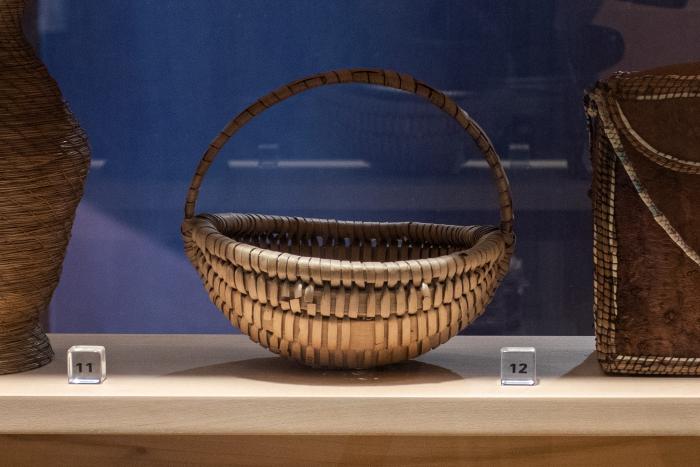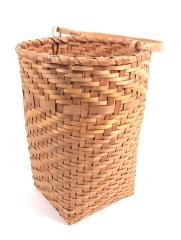Comments and Tags
Be the first to comment on this item!
Native American
Native American - Northeast and Southeast Woodland
Food and Drink ➔ Basket
Identifier:
115775Description:
This small melon basket is made of ash splints by the Ottawa near Eastmanville, Michigan. It was given to John Ball around 1860 and donated to the museum by his daughter Flora in 1943.
Date:
1855 – 1865Materials:
Ash SplintsCurrent Location Status:
In StorageCollection Tier:
Tier 2Source:
Gift Of Flora BallExhibits/Programs:
Anishinabek: The People of this Place (1995 – 2025)Anishinaabek: The Original People of This Place (after 2026)
Redesign of the Anishinabek: The People of this Place exhibit. Ideas for potential artifacts.
Related Entities:
Ottawa (creator)Alternate names: Odaawa, Odawa Flora Ball Hopkins (donor)
Flora Ball Hopkins was born in Grand Rapids, Michigan on April 20, 1858, to John Ball and his wife Mary. She married Myron Hopkins in December of 1890 and together they had a son named Myron Ball Hopkins. In 1918 Flora volunteered for the Women's Committee of the Council for National Defense--Michigan Division to help World War I efforts. Later, with her sisters Kate Ball Powers and Lucy Ball, she helped John Ball write his autobiography entitled Born to Wander. Flora died on March 20, 1954, at the age of 95. John Ball (is related to)
John Ball (November 12, 1794-February 5, 1884) was born in New Hampshire to Nathaniel Ball and Sarah Nevins Ball. He grew up in the agricultural community of Tenny Hill, Hebron, in Grafton County.
After receiving a common school education from a local clergyman, he attended and graduated from Darmouth College in 1820 and studied law for two years in New York. He was admitted to the New York Bar Association in 1824. In 1832, he traveled to Oregon under Nathaniel Jarvis Wyeth and was employed as the first white teacher of Oregon, teaching the children at Fort Vancouver for a year.
In the spring of 1833, John McLoughlin, Ball’s former employer, gave him the supplies needed to settle in Salem, Oregon and start a farm. He was one of the first Americans to farm on the French Prairie, among French-Canadians who had been settling in the area for several years. However, by autumn he was tired of the “primitive life” of farming and sold his wheat crop for a year-long sea voyage back to the United States, via the Hawaiian Islands and Cape Horn. He returned to Lansingburgh in New York but shortly thereafter settled in Grand Rapids, Michigan, in 1837.
In Grand Rapids, Ball opened a law office, partnering with former Chief Justice of Michigan George Martin and United States District Judge Solomon Lewis Withey. In 1842, Governor John Barry appointed Ball to select 3/5 of the land granted to the state by Congress for internal improvements. Ball selected mostly lands around Grand Rapids and contributed to a significant rise in the settlement of the Grand River Valley.
As a prominent figure in Grand Rapids, Ball invested in community schools and lyceums. During his service as Michigan State Representative in the 1830s, he was a key figure in the establishment of a public school system in Michigan. In 1854, he helped found the Grand Rapids Lyceum of Natural History, the predecessor to the Grand Rapids Public Museum, and donated to its first collections, the “Cabinets of Curiosities.” At his death in 1884, he willed the land that is now John Ball Park and John Ball Zoo to the city of Grand Rapids.
John Ball died on February 5, 1884 in Grand Rapids. He is buried in Fulton Street Cemetery.

